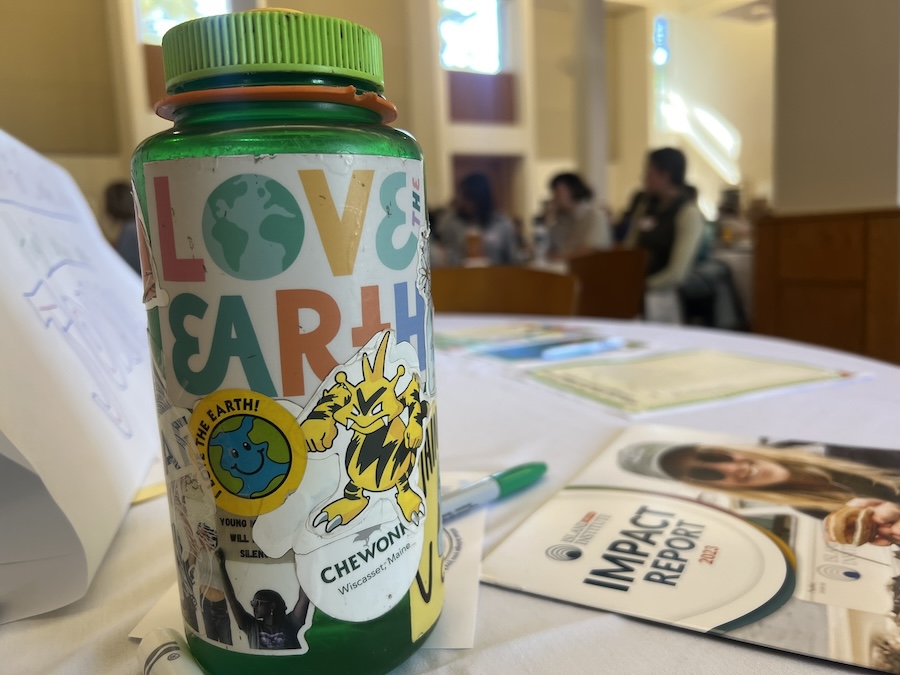Three Standout Environmental Studies Students Identify Ways to Help the Planet
By Rebecca GoldfineBrie Cunliffe ’22, Samara Nassor ’22, and Mattie Thomas ’22 recently presented their theses to the environmental studies department. They were advised by professors Anne Hayden and Eileen Sylvan Johnson.
“This year’s honors projects demonstrated the strength and opportunity of interdisciplinary scholarship," Johnson said. "Each honor student tackled a critical environmental issue and applied an interdisciplinary lens to chart a pathway forward."

Cunliffe's project, "Forests as Fuel? An Investigation of Biomass's Role in a Just Transition," explores misinformation promulgated by the biomass industry. Her research undermines its central claim that the wood pellets it manufactures for industrial electricity generation are environmentally beneficial.
In fact, she points out, while biomass is efficient at generating heat, it is not efficient at creating electricity; it actually burns dirtier than coal. One plant can produce 2.4 million tons of carbon dioxide emissions a year—the equivalent of putting 473,000 more gas-fueled cars on the road.
At the same time, the plants are relying on harvesting surrounding forests, which act as carbon sinks. Between 4,000 and 30,000 acres of forests are cut for biomass energy every year, she reported, and can't grow back fast enough to help stem the worst effects of climate change.
Cunliffe, an environmental studies and government major, focused her research on the intersection of environmental and social justice movements, noting that new biomass factories are being sited in disadvantaged communities in the southern US. These plants primarily produce pellets for European electricity under the guise of being a renewable and green energy source.
"Every single biomass wood pellet plant in North and South Carolina is located in an environmental justice community," she said, which means they are mostly made up of people of color and have poverty rates below the state median. Additionally, these "communities already experience pollution from industrial agriculture and other power generation," she said.
Despite the pattern of staunch regulatory support of biomass by state actors, local biomass resistance is gaining momentum. A proposed plant Lumberton, North Carolina, was just abandoned in April. A slew of negative media coverage has been published recently, "slamming biomass from a climate standpoint and an environmental justice standpoint," Cunliffe said.
"Public opinion matters for biomass because its entire demand structure is contingent on its designation as green," particularly in Europe, Cunliffe said.
Cunliffe summarized the hopes of people living in communities affected by biomass. "When you ask folks involved in this struggle what they envision for the future, their answers look like true renewables [and] new processes for incorporating community voices into policy," as well as for climate action plans that don't leave some groups behind.

Nassor started her talk about her research project, "An Investigation on Data Gaps in Scope 3 Emissions Accounting and Disclosure," by noting that countries are lagging in their climate goals. Part of the problem is that between 8.5 billion and 13.3 billion tons of carbon dioxide emissions are being underreported.
"At the same time," Nassor said, "the responsibility of accounting for emissions lies in the hands of companies that make up a large portion of global emissions... Just 100 companies are responsible for over 71 percent of emissions worldwide."
Nassor, who is an environmental studies and government major, took a closer look at the data to see if she could determine how companies are missing the mark, zeroing in on what are called Scope 3 emissions, or emissions generated by supply chains. "Scope 3 emissions make up 74 percent of emissions on average," she explained.
After analyzing 2010-2021 data from the Carbon Disclosure Project, she found that one source of reporting noncompliance comes from companies inconsistently disclosing emissions data year to year. Additionally, companies are not consistent with sample sizes, making it difficult to compare pollution levels over time.
When companies do report emissions, they often "greenwash" the numbers, Nassor said, scrambling reality through a variety of different techniques, such as omitting data, offering vague goals, making symbolic but empty gestures, providing deliberately confusing information, and selectively supplying information.
"Fortunately," Nassor concluded, "there are solutions" to patching Scope 3 gaps in CO2 reporting. These include partnering with emission accounting organizations and groups, using artificial intelligence that takes advantage emission modeling software, establishing external standards, and strengthening policy.

After researching the federal relicensing process for hydropower dams, Thomas argues in his thesis, "Evaluating Dam Relicensing and River Herring Habitat Restoration from a Broad, Multi-Ecosystem Perspective," for a more transparent regulatory process that better balances ecological concerns with power generation goals.
Dams began cropping up on many of Maine's rivers in the nineteenth century with little oversight. While they produce enormous amounts of clean electricity, they also block fish like river herring from migrating upstream to spawn.
"By 1828, all major river systems in Maine had at least one dam, and by 1850, 95 percent of inland spawning habitat was obstructed by the presence of major dams," Thomas, and environmental studies and government major, said.
The collapse of the river herring population—which is currently at 1 percent to 8 percent of historic levels—has had destructive ripple effects, contributing to the collapse of major groundfish species like cod.
But it will be challenging to restore the river herring population, as it would require between 90 percent and 100 percent of the fish reaching their upstream spawning grounds. Currently, fish-run infrastructure designed to help herring surmount dams let less than half of the migrating fish through.
Dams come up for relicensing every thirty to fifty years. As part of his research, Thomas devised a matrix that regulators can use to easily evaluate whether a dam should be relicensed or denied a license and removed. The grid compares the power the dam generates to how much it obstructs fish passage.
For example, he recommends that all four dams on the Kennebec River—which are currently up for renewal—be denied a license. Cumulatively, they provide 0.43 percent of electricity for Maine's power grid while having "an outsized impact" on fish species.
He also argues that as more solar and wind power comes online, Maine can rely less on the green energy of hydropower dams while still, in time, achieving its climate change goals.
Besides balancing ecological considerations with power generation, Thomas points to other positives to restoring the herring population—which would be felt throughout Maine and its sea, the Gulf of Maine.
"The benefits of removing dams come along with increased ecosystem resilience," he said. "Resilient ecosystems will be better equipped to mitigate and adapt to the impacts of climate change in the future."



